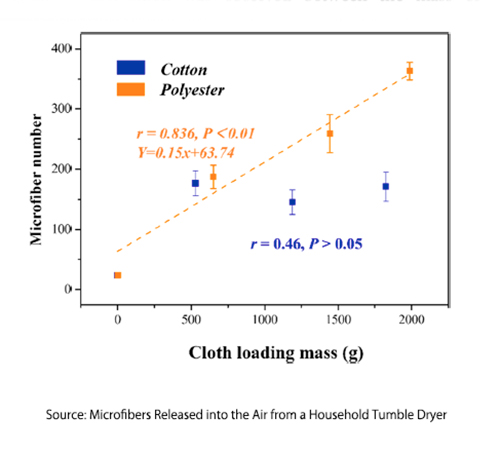
The drumbeat of concern over microplastics continues. Unlike other potential pollutants, the primary “threat” comes from our homes, most notably our clothing. While micro and even smaller nanoplastics are shed while we walk about in apparel, a new study points to washing and drying as releasing these possible health risks.
“The number of microfibers released into the environment by washing textiles might increase to 70,000 tons per year, which is equivalent to dumping 400 million polyester T-shirts into the sea.”
Well, that certainly sounds ominous. That figure is ultimately derived from studying the microfibers released during washing. Polyester T-shirts produce more than cotton T-shirts, on the order of 212 particles per garment per wash. Before panicking, it should be noted that these tests were conducted using new clothing and that the shedding of microplastics declines with repetitive washes. More importantly, as our current researchers write,
“Fortunately, since most laundry water is treated by sewage treatment plants, such large quantities of microfibers would be unlikely to be discharged into aquatic environments, but they might enter other environments associated with biosolids. [landfills]”
Given the impact of washing on the release of microplastics, the researchers turned their attention to our tumble dryers. The methodology of the study was as straightforward as can be. Two types of fabric, polyester and cotton, were tumble-dried for fifteen minutes, and an air sampler at the end of the ducting collected all airborne particles. The particles were subsequently filtered by size to separate micro and nanosize particles.

- A mean of 270 microfibers was collected from polyester textiles, and this amount seemed to vary with the number of garments dried
- A mean of 165 microfibers was observed for cotton textiles. There was no correlation between microfibers released and the number of cotton garments dried.
Let the Multiplication Begin
Those numbers reflect one drying cycle and seem inconsequential. 270 particles are hard to visualize, and when in advocacy mode, bigger numbers draw more attention.
“It was estimated that 93,635 and 72,188 microfibers could be released from 1 kg of polyester and cotton textiles, respectively, during a 15 min drying process.”
It's better, but here is an even larger number.
“The estimated number of microfibers produced per dryer could be between 433,128 (6 kg cotton textiles) and 561,810 (7 kg polyester textiles) microfibers per 15 min drying cycle.”
Now, we are sharing thousands of times greater numbers. A number that support the idea that
“…tumble dryers are, therefore, likely to represent a substantial contribution to microplastic contamination in the environment globally.”
Cotton microfibers are no longer mentioned because of their decreased ability to bioaccumulate, another way of saying they degrade more quickly.
What to do?
Unlike other potential pollutants, the release of microplastics from clothing is primarily under our control. Adding fabric softeners to the wash reduces the friction between fibers, can reduce microplastics released during washing, and reduces the damage to those fibers that can create microplastics during drying. Unfortunately, there are concerns by the water environmentalists that those fabric softeners can and do enter our water supply.
In this study, the researchers suggest the addition of an additional microfiber trapping filter to mitigate this possible problem. However, manufacturers will not necessarily willingly redesign, with increased costs, nor is it clear how often we will have to clean or swap out that additional filter.
With only the heavy hand of legislation, the government might offer incentives to stimulate demand or subsidize design costs. Or they might, as they have for our newfound villain, the gas stove, simply outlaw driers, although the cry from those of us doing the laundry will surely doom that approach.
It is unclear whether the continued drumbeats of microplastic concerns are essential to our health, let alone sufficient to drive us to make new personal choices. Will we honor our deeds over our words, adopt new laundry habits, and support advancements in appliance design, or leave the decisions, necessary or not, to the government?
Source: Microfibers Released into the Air from a Household Tumble Dryer Environmental Science and Technology Letters DOI: /10.1021/acs.estlett.1c00911



